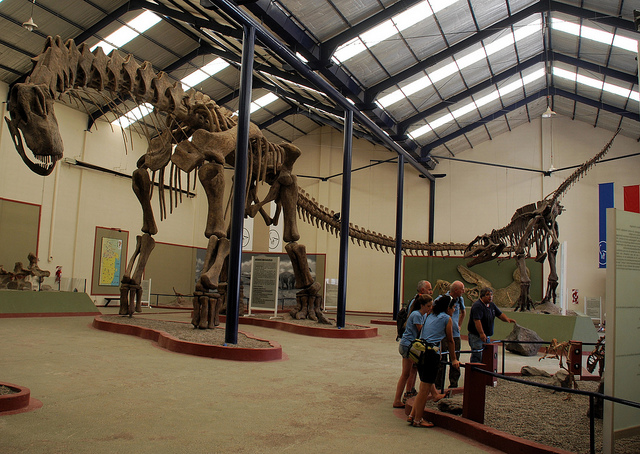The best place to see an on-site excavation is the Centro Paleontológico Lago Los Barreales. At this reservoir northwest of Neuquén, paleontologists demonstrate the separation and rescue of fossil deposits as well as the cleaning and extraction of the fossils themselves. Beasts in the sediments here include the sauropod Futalognkosaurus (a long-tailed quadruped with a long neck and small head), teropods (bipedal carnivores with huge claws, such as Megaraptor), and ornithopods (small bipedal herbivores), along with bivalves, crocodiles, turtles, and pterosaurs.
Unfortunately, a political controversy has recently closed the site to the public. Determined visitors should contact the provincial Subsecretaría de Turismo in the city of Neuquén for more information.

A replica skeleton of Argentinosaurus huinculensis, the world’s largest dinosaur (35m long) at Museo Municipal Carmen Funes. Photo © OggiScienza, licensed Creative Commons Attribution No-Derivatives.
At the oil town of Plaza Huincul, midway between Neuquén and Zapala, is the Museo Municipal Carmen Funes (Av. Córdoba 55, tel. 0299/4965486, 9am-7pm Mon.-Fri., 10:30am-8:30pm Sat.-Sun., US$3). The prize exhibit is a replica skeleton of Argentinosaurus huinculensis, which measures 35 meters long and 18 meters high. The herbivore A. huinculensis is so large that an adult male human barely reaches its knee, and one of its dorsal vertebrae measures 1.6 meters.
In 1987, former oil worker Guillermo Heredia found the fossil three kilometers away, along the highway. In addition to the imposing skeleton, there are models of the carnivorous Mapusaurus and several smaller dinosaurs, a clutch of dinosaur eggs some 80 million years old, and remains of crocodiles found in Picún Leufú, about 75 kilometers south.
Buses from Neuquén are frequent.
Plaza Huincul boasts the world’s largest herbivore, but Villa El Chocón claims its carnivorous counterpart in Giganotosaurus carolinii. The dinosaur takes its name from amateur paleontologist Rubén Carolini, who discovered the fossil. Measuring 14 meters in length and 4.65 meters high at the hip, it weighed up to eight tons.
Above an enormous hydroelectric reservoir southwest of Neuquén, the Museo Paleontológico Municipal Ernesto Bachmann (Centro Cívico s/n, tel. 0299/4901230, 8am-7pm daily, US$1) features models of Carnotaurus and the smaller Pianitzkysaurus, as well as exhibits on the area’s archaeology and a whitewashed account of the dam and former ranch owner Manuel Bustigorry. There are also dinosaur tracks in the vicinity. Unfortunately, because the massive hydroelectric dam drowned the Río Limay’s sedimentary canyon here, many probable paleontological sites have disappeared beneath the water.
Villa El Chocón, 80 kilometers southwest of Neuquén via RN 22 and RN 237, originated as a company town during the dam’s construction. Dirección Municipal de Turismo (RN 22 junction, [email protected], tel. 0299/4901223, 8am-7pm daily) is the town’s tourist office.
On the shoreline, La Posada del Dinosaurio (tel. 0299/4901200, US$66 s, US$89 d) offers excellent accommodations, with a good, reasonably-priced restaurant and outstanding service. There’s camping nearby.
Excerpted from the Fourth Edition of Moon Patagonia.